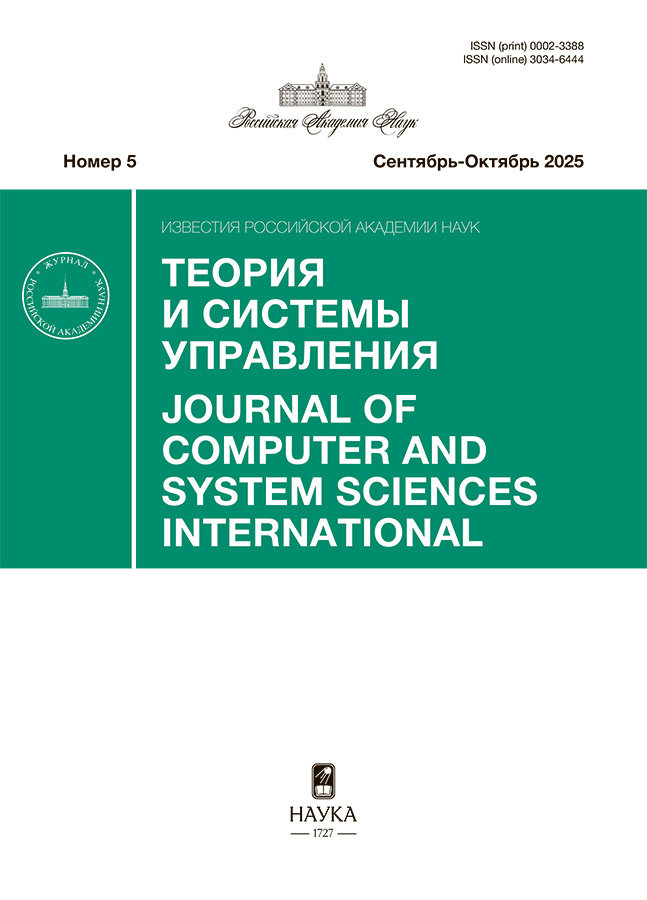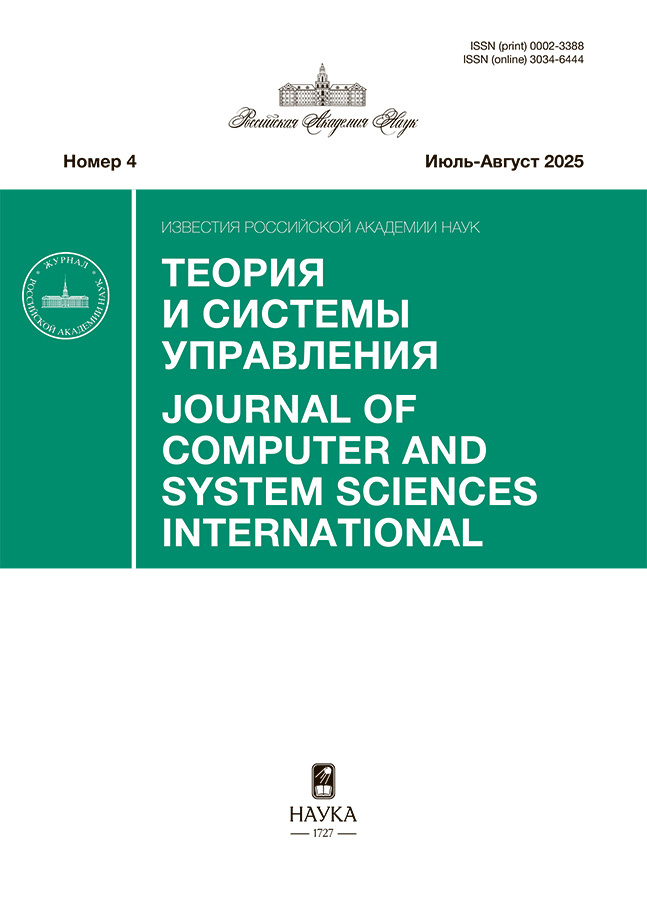№ 4 (2025)
ТЕОРИЯ СИСТЕМ И ОБЩАЯ ТЕОРИЯ УПРАВЛЕНИЯ
О решении задачи 0-управляемости линейных дискретных систем со скалярным суммарно ограниченным управлением
Аннотация
Для линейных систем с дискретным временем предложен подход к построению закона ограниченных управлений как функций текущего состояния. Идея основана на использовании информации о множествах 0-управляемости.
 5-34
5-34


Об учете голономных связей при построении уравнений движения управляемых механических систем
Аннотация
Рассматривается управляемое движение механических систем. Программное движение задается в форме голономных связей. Уравнения движения составляются на основе уравнений Лагранжа без требования идеальности накладываемых связей. Для модельных задач получены различные законы движения и реакции связей.
 35-42
35-42


УПРАВЛЕНИЕ В СТОХАСТИЧЕСКИХ СИСТЕМАХ И В УСЛОВИЯХ НЕОПРЕДЕЛЕННОСТИ
Оперативно-оптимальный конечномерный динамический регулятор состояния стохастического дифференциального объекта по его выходу. II. Линейно-гауссовский объект с неточными измерениями состояния и квадратично-биквадратный критерий
Аннотация
Приводится полученный в первой части данной статьи общий алгоритм выполняемого последовательно во времени синтеза оптимального в среднем быстрого динамического регулятора выбираемого порядка для случая неточных измерений выхода нелинейного стохастического объекта управления. Демонстрируется его применение к частной задаче управления линейно-гауссовским объектом при переменном критерии качества, квадратичном по управлению и состоянию регулятора, но квадратично-биквадратном по состоянию объекта. Показано, что оптимальные нелинейные структурные функции уравнения состояния регулятора и формулы его выхода в этом случае выражаются через три первых начальных момента условной плотности вероятности, которая определяется решением задачи Коши для нелинейного уравнения в частных производных, полученного из уравнения Фоккера–Планка–Колмогорова. Для нахождения приближенно-аналитического вида этих функций применен метод гауссовской аппроксимации, что свело задачу к получению последовательным методом Монте-Карло зависящих только от времени коэффициентов некоторых нелинейностей. Показано, что биквадратичность критерия приводит к полезному полиномиальному виду структурных функций гауссовского регулятора до третьей степени включительно, тогда как в случае квадратичного критерия получаем линейный регулятор порядка объекта, удовлетворяющий теореме разделения Вонэма.
 43-60
43-60


ОПТИМАЛЬНОЕ УПРАВЛЕНИЕ
Приведение космического аппарата с управляемым вектором тяги в заданное место посадки с минимальным расходом топлива
Аннотация
Рассматривается задача о приведении космического аппарата в заданное положение над определенным местом посадки на поверхность планеты. С использованием принципа максимума Понтрягина задача оптимального управления сводится к краевой для системы нелинейных дифференциальных уравнений. Проводится качественный анализ оптимальных фазовых траекторий системы, устанавливаются их свойства, проиллюстрированные результатами численного моделирования. Аналитически описаны области в плоскости фазовых переменных, из которых возможно достижение терминального множества. Построен синтез оптимального управления.
 61-76
61-76


УПРАВЛЕНИЕ СИСТЕМАМИ С РАСПРЕДЕЛЕННЫМИ ПАРАМЕТРАМИ
Оптимальное управление в линейно-квадратичных задачах оптимизации гиперболических систем с распределенными параметрами
Аннотация
Предлагается конструктивный метод решения линейно-квадратичной задачи оптимального управления гиперболическими системами с распределенными параметрами в условиях оценки в равномерной метрике целевых множеств конечных состояний управляемой величины и скорости ее изменения во времени. На рассматриваемый круг задач распространяется разработанный ранее альтернансный метод построения алгоритмов программного управления. Соответствующая методология использует процедуру параметризации искомых управляющих воздействий на конечномерном подмножестве бесконечного числа финишных значений сопряженных переменных и последующую операцию точной редукции к параметрической задаче полубесконечной оптимизации, которая решается по обобщаемой на исследуемые ситуации схеме применения альтернансного метода. Показывается, что искомые уравнения оптимальных регуляторов сводятся к линейным с нестационарными коэффициентами законам обратной связи по измеряемому выходу объекта. Приводится представляющий самостоятельный интерес пример решения задачи оптимального по энергопотреблению управления объектом, описываемым волновым уравнением математической физики.
 77-93
77-93


КОМПЬЮТЕРНЫЕ МЕТОДЫ
Методы построения ансамблей предикторов на основе выпуклых комбинаций
Аннотация
При решении задач регрессии построение выпуклых комбинаций предикторов само по себе является эффективным методом построения ансамблей. При этом, если специально строить набор исходных предикторов с целью их дальнейшего использования в ансамбле, представляется возможным улучшить итоговое качество алгоритма. Исследуются два способа, позволяющие добиваться такого улучшения: модификация обучающих данных с помощью выборки объектов с возвращением в сочетании с методом случайных подпространств (по аналогии с методом Bootstrap Aggregating или бэггингом) и оптимизация разброса предикторов. Эффективность разработанных методов подтверждается результатами, полученными для конкретных прикладных задач.
 94-102
94-102


Анализ взаимосвязей между наборами чисел путем построения решающих деревьев
Аннотация
Рассматривается проблема, как проанализировать статистические взаимосвязи между наборами натуральных чисел. Предполагается, что наборы разбиты на именованные диапазоны, например числовые значения психологических показателей, полученные в ходе тестирования фокус-группы. Анализ предлагается выполнять при помощи решающих деревьев. Цель работы – предложить математический инструмент, позволяющий применить решающие деревья для проверки гипотезы касательно наличия или отсутствия взаимосвязей между двумя и более наборами чисел. Наборы упорядочены по возрастанию и разбиты после этого на диапазоны. Предложен новый подход анализа статистических зависимостей между наборами числовых значений экспериментальных показателей. Изложены преимущества нового подхода по сравнению с тем, что был представлен ранее в рамках разработки математического и алгоритмического обеспечения для анализа количественных результатов тестирований.
 103-121
103-121


СИСТЕМНЫЙ АНАЛИЗ И ИССЛЕДОВАНИЕ ОПЕРАЦИЙ
Предельные характеристики многопользовательской сети связи при изменении пропускной способности разрезов
Аннотация
Исследуются предельные показатели функциональных возможностей многопользовательской системы связи при изменении пропускной способности ребер сети. На основе маршрутов передачи максимальных потоков одного вида определяются узкие места сети – минимальные разрезы. Изучается влияние изменения пропускной способности ребер разрезов на предельно допустимые межузловые потоки при монопольных режимах управления. Найденные предельные значения межузловых потоков отвечают угловым точкам множества допустимых потоков, удовлетворяющих ограничениям модели. С помощью выпуклой комбинации векторов, соответствующих угловым точками, производится оценка относительных изменений характеристик сети при деформации множества достижимых потоков. Формируются многокритериальные гарантированные оценки максимально возможных отклонений от эталонных показателей функционирования сети. Приводятся итоговые диаграммы для сетей с различными структурными особенностями.
 122–131
122–131


ИСКУССТВЕННЫЙ ИНТЕЛЛЕКТ
Использование негативных действий пользователей для улучшения качества рекомендательных систем
Аннотация
Рекомендательные системы находят все более широкое применение, охватывая множество сфер. Вместе с тем возрастает количество нестандартных случаев, связанных с необычными типами данных, на которых традиционные подходы не всегда эффективны. Например, при ограниченном количестве объектов более результативным решением становятся методы, основанные на обычных алгоритмах классификации. Предлагается способ повышения качества рекомендаций в рамках такого подхода за счет учета негативных взаимодействий пользователей с объектами. Интеграция этой информации позволяет более точно моделировать как предпочтения, так и избегаемые элементы. Представленный метод улучшает персонализацию рекомендаций даже в условиях высокой взаимосвязанности и ограниченности количества объектов.
 132-148
132-148


РАСПОЗНАВАНИЕ ОБРАЗОВ И ОБРАБОТКА ИЗОБРАЖЕНИЙ
Алгоритм измерения текстурных характеристик по комбинации спектров Фурье изображений в направленном свете
Аннотация
Предлагается новый алгоритм измерения текстурных характеристик объектов на изображениях. Новизна алгоритма заключается в использовании пар изображений, зафиксированных в направленном свете, и комбинировании их образов в частотной области. Применение разработанного алгоритма продемонстрировано при решении задачи подсчета нитей тканых основ произведений живописи по изображениям. Вычислительный эксперимент показал, что ошибка измерения плотности холста не превышает 0.4 нити на сантиметр. Проведено сравнение точности измерения плотности холста различными методами. Предлагаемый алгоритм позволяет измерить характеристики холстов картин с фактурой, искаженной сильным загрязнением, просачиванием грунта или обработкой реставрационными материалами, и превосходит по точности применявшиеся ранее алгоритмы. С использованием нового алгоритма выполнено измерение плотности холстов семи картин из собрания Государственного исторического музея. Разработанный алгоритм может применяться для решения широкого круга практических задач, включая обработку и анализ аэрофотоснимков.
 149-159
149-159


НАВИГАЦИОННЫЕ СИСТЕМЫ
К вопросу о совершенствовании ГЛОНАСС на основе использования перспективных лазерных и квантово-оптических средств
Аннотация
Рассматривается задача совершенствования характеристик ГЛОНАСС в контексте перспектив развития других глобальных спутниковых навигационных систем. В качестве ключевых направлений представлены исследования и разработки, связанные с интеграцией в технологические процессы функционирования орбитальной группировки перспективных лазерных и квантово-оптических аппаратных средств. Обсуждаются основные факторы, препятствующие в текущий момент совместной обработке формируемых на борту и на земле измерений от различных источников. Предложены пути компенсации влияния этих факторов на базе создания и внедрения специальных информационных технологий сличения шкал времени, оцифровки измерений и уточнения задержек в трактах функционирования оптических аппаратных средств. Приведены результаты экспериментов по обработке формируемых таким образом измерений и оцениванию перечисленных выше параметров. Сформулированы выводы относительно возможного использования аппаратных средств и информационных технологий в интересах повышения точностных характеристик ГЛОНАСС.
 160-170
160-170


Интеграция инерциальной и оптической навигационных систем на основе методов стохастического нелинейного оценивания
Аннотация
Одним из наиболее высокоточных методов решения задачи автономной навигации является обработка оптической информации, снимаемой в процессе движения объекта. Существующие методы обработки оптического потока, построенные на определении так называемого поля скоростей, позволяют оценить лишь проекции линейной и угловой скоростей объекта. Что в свою очередь является лишь частью общей задачи навигации – оценки текущих координат объекта и параметров его пространственной ориентации. В связи с ограниченными возможностями подобных оптических навигационных систем предлагается комплексирование оптической навигационной системы, преимуществом которой служит устойчивое на произвольном интервале времени автономное наблюдение параметров линейного и углового движения (причем с минимальными по стоимости аппаратными затратами) с инерциальной навигационной системой. Ее функциональные возможности обеспечивает решение задачи автономной навигации в целом. В силу неизбежных помех различной физической природы, в существенной степени искажающих измерения упомянутых навигационных систем, синтез рассмотренной интегрированной инерциально-оптической системы был осуществлен с использованием методов современной теории стохастической фильтрации, наиболее эффективных при оценке параметров состояния в условиях помеховой обстановки. В качестве алгоритма оценки вектора навигационных параметров объекта по измерениям разработанной инерциально-оптической системы навигации был выбран расширенный фильтр Калмана, модифицированный с учетом корреляции шумов объекта и наблюдателя. Приведены результаты численного эксперимента, иллюстрирующего эффективность предложенного подхода.
 171-184
171-184













